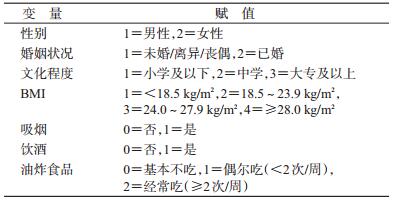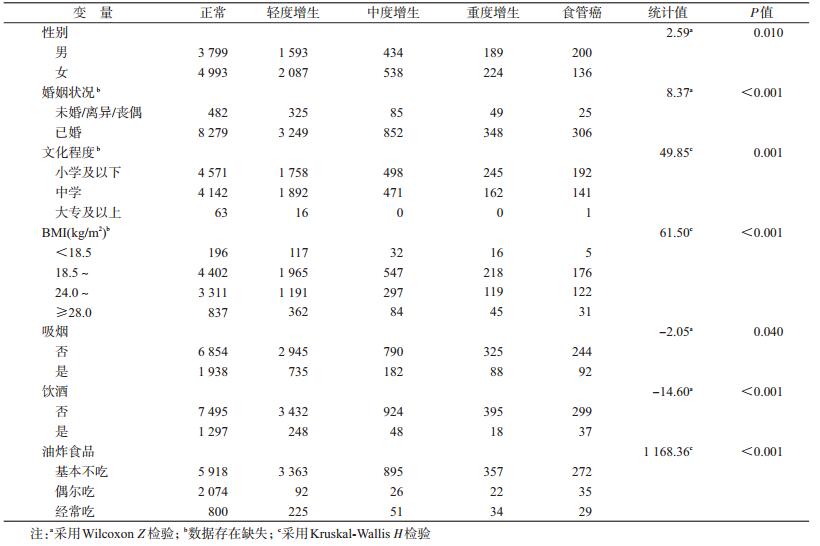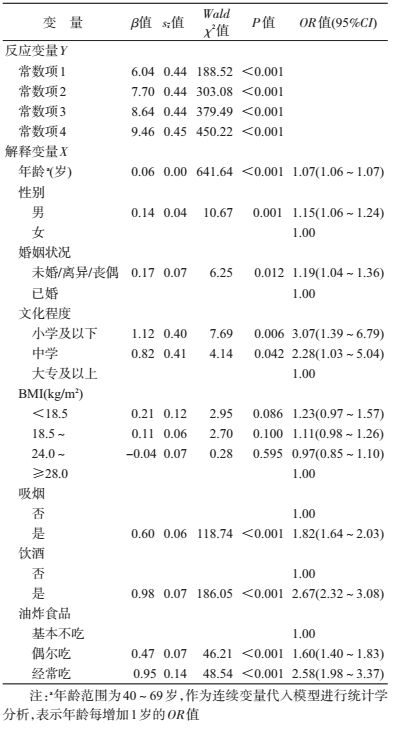文章信息
- 郭兰伟, 刘曙正, 张萌, 陈琼, 张韶凯, 孙喜斌.
- Guo Lanwei, Liu Shuzheng, Zhang Meng, Chen Qiong, Zhang Shaokai, Sun Xibin.
- 油炸食品与食管癌及癌前病变关系的多元有序logistic回归分析
- Multivariate ordinal logistic regression analysis on the association between consumption of fried food and both esophageal cancer and precancerous lesions
- 中华流行病学杂志, 2017, 38(12): 1616-1619
- Chinese journal of Epidemiology, 2017, 38(12): 1616-1619
- http://dx.doi.org/10.3760/cma.j.issn.0254-6450.2017.12.006
-
文章历史
收稿日期: 2017-06-27
2. 100021 国家癌症中心/中国医学科学院北京协和医学院肿瘤医院 城市癌症早诊早治项目办公室
2. Program Office for Cancer Screening in Urban China, National Cancer Center/Cancer Hospital, Chinese Academy of Medical Sciences, Peking Union Medical College, Beijing 100021, China
2013年河南省农村地区食管癌发病率为31.35/10万[1],约为同期全国平均水平的1.6倍[2];死亡率为21.74/10万[1],约为同期全国平均水平的1.5倍[2]。2005年我国启动了农村上消化道癌(食管癌、贲门癌和胃癌)筛查和早诊早治公共卫生项目工作,到2013年筛查地区扩大到26个省份的110个市(县)。河南省自2005年在林州市(林县)农村人群开展食管癌筛查项目以来,到2013年全省开展食管癌筛查的地区已扩展至12个。本研究对首次筛查数据进行统计分析,探讨油炸食品摄入与食管癌及癌前病变发病的关系,为今后食管癌及癌前病变的预防与及早采取防治措施提供依据。
对象与方法1.研究对象:以2005-2013年开展上消化道癌症筛查项目的11个行政县/市(林州市、济源市、辉县市、偃师市、内乡县、鹤壁市、滑县、鲁山县、固始县、嵩县和博爱县)的居民为研究对象,根据户籍资料信息以村为单位完成全人口注册登记,对40~69岁的居民进行基本信息登记和危险因素问卷调查,对签署了知情同意书但无内镜检查禁忌症的人群按照自愿原则进行碘染色内镜筛查,内镜医师根据内镜检查可疑病变点位取活检,并由病理医师进行病理诊断。依据病理诊断标准将食管癌及癌前病变分为不同病变等级(包括轻度异型增生、中度异型增生、重度异型增生或原位癌、黏膜内癌、黏膜下癌和浸润癌)。本研究通过中国医学科学院肿瘤医院伦理委员会审查。
2.研究方法:采用上消化道癌早诊早治项目基本信息调查表,所有研究对象均告知调查目的,在签署知情同意后参与调查,由经过专门培训的人员统一发放调查表并进行询问,调查表经审核后验收,在分析资料前对调查表进行复核。调查内容主要包括一般情况(年龄、性别、身高、体重、民族、婚姻状况、文化程度、收入状况等)、日常生活行为习惯(吸烟、饮酒)、饮食习惯等。研究对象纳入标准:首次参加上消化道癌筛查项目;年龄、性别、吸烟状况、饮酒状况、油炸食品食用频率等信息无缺失;内镜下检查无异常的对象作为正常对照;如为食管病变病例,病理信息无缺失。
3.统计学分析:采用Excel 2003软件进行数据收集和汇总,应用SPSS 19.0软件对数据进行统计学分析。食管癌及癌前病变影响因素的单因素分析采用秩和检验(两样本采用Wilcoxon Z检验,多样本采用Kruskal-Wallis H检验)。多因素分析采用多元有序logistic回归分析,赋值见表 1。采用双侧α=0.05,以P<0.05为差异有统计学意义。
1.一般情况:共收集参加内镜筛查对象82 367例,年龄为(53.46±8.07)岁。共纳入食管正常8 792例、轻度增生3 680例、中度增生972例、重度增生/原位癌413例、食管癌336例。研究结果显示,性别、婚姻状况、文化程度、BMI、吸烟、饮酒、油炸食品食用频率均与食管癌及癌前病变的发生相关(P<0.05)。见表 2。
2.油炸食品与食管癌及癌前病变关系的多因素分析:以发生食管癌及癌前病变不同病变等级为因变量(0=正常食管,1=食管轻度增生,2=食管中度增生,3=食管重度增生,4=食管癌),以单因素分析结果有意义的因素为自变量进行多因素分析。多因素分析结果显示,年龄(OR=1.07,95%CI:1.06~1.07)、男性(OR=1.15,95%CI:1.06~1.24)、未婚/离异/丧偶(OR=1.19,95%CI:1.04~1.36)、文化程度低(小学及以下:OR=3.07,95%CI:1.39~6.79;中学:OR=2.28,95%CI:1.03~5.04)、吸烟(OR=1.82,95%CI:1.64~2.03)、饮酒(OR=2.67,95%CI:2.32~3.08)和油炸食品摄入(偶尔:OR=1.60,95%CI:1.40~1.83;经常:OR=2.58,95%CI:1.98~3.37)是食管癌及癌前病变发生的独立危险因素(P<0.05)。调整年龄、性别、婚姻状况、文化程度、BMI、吸烟和饮酒状况后,油炸食品摄入频率越高,食管癌发病风险增加。见表 3。
世界癌症研究基金会和美国癌症研究所2007年出版《食物、营养与癌症预防》报告显示,饮食因素被认为是肿瘤发生发展的重要因素。有流行病学研究结果显示:食用油炸食品与结肠癌、肺腺癌以及乳腺癌的发生有关[3-5]。已有多项流行病学研究针对饮食因素与食管癌的关联及其关联强度进行了报道,但所得结论并不一致。骆善彩等[6]利用淮河流域早诊早治项目数据的一项研究结果显示,每周食用2~4次油炸食品是食管癌及癌前病变发生的危险因素(OR=2.10,95%CI:1.41~3.15),与本研究结果较为一致;另外一些研究同样显示,经常食用油炸食品会增加食管癌发病风险[7-8]。而其他一些研究没有得到食用油炸食品与食管癌发病之间的关联[9]。
高温油炸富含蛋白质的食物会产生一些挥发性以及不挥发性致癌物质[10],比如高温油炸过程中会产生丙二醛、乙醛、丙烯醛、1,3丁二烯、环氧乙烷等挥发性的致癌物质,在一些炸肉表面也检测到杂环胺和多环芳烃、丙烯酰胺等不挥发性致癌物质。动物模型结果显示,杂环胺类化合物可以诱导肿瘤生成,比如乳腺癌、结肠癌等[7]。杂环胺类化合物形成中重要的因素包括烹饪的温度(>150 ℃)、烹饪时间(>2 min)以及烹饪方法(油炸、烧烤)。因此,油炸过程中会产生较多杂环胺类致癌物质,导致人类肿瘤的发生。
本研究结果显示,吸烟、饮酒是食管癌及癌前病变发生的独立危险因素,这与以往的研究一致。既往研究已经证实,吸烟与饮酒是西方发达国家食管癌发生的主要危险因素,且二者存在一定的协同作用,在西方发达国家超过90%的食管鳞癌归因于吸烟与饮酒[11]。国内多项研究结果也显示,吸烟、饮酒是食管癌重要的危险因素,Wang等[12]研究结果显示,中国人群17.90%的男性与1.90%的女性食管癌发病与死亡归因于吸烟,15.20%的男性与1.30%的女性食管癌发病与死亡归因于饮酒。
烟草中含有60多种致癌物质[13-15],如4-(甲基亚硝胺)-1-(3-吡啶基)-1-丁酮、丙二醛、多环芳烃、丙烯酰胺、苯并芘、乙醛等,这些致癌物的代谢产物可能导致基因突变从而导致癌前病变甚至癌症[16]。酒精能够激活CYP成员,从而激活烟草中的致癌物而引起致癌作用[16]。除此之外,酒精还能够增加细胞膜的通透性,可作为一种溶剂促进烟草中的多环芳烃等致癌物质进入食管黏膜细胞中[16]。也有研究显示,长期饮酒者其唾液腺形态改变且唾液流动减少,口腔中的细菌浓度增加,而口腔细菌能够激活烟草中的亚硝胺形成致癌加合物[17-18]。
综上所述,油炸食品是食管癌及癌前病变发生的危险因素。另外,吸烟、饮酒等传统危险因素是威胁食管健康的重要因素。
志谢: 感谢参加河南省农村上消化道癌筛查项目的所有现场调查及项目管理的工作人员利益冲突: 无
| [1] |
张建功, 刘曙正.2016河南省肿瘤登记年报[M]. 北京: 军事医学出版社, 2017.
Zhang JG, Liu SZ.2016 Henan Cancer Registry Annual Report[M]. Beijing: Military Medical Publishing House, 2017. |
| [2] |
陈万青, 郑荣寿, 张思维, 等.
2013年中国恶性肿瘤发病和死亡分析[J]. 中国肿瘤, 2017, 26(1): 1–7.
Chen WQ, Zheng RS, Zhang SW, et al. Report of cancer incidence and mortality in China, 2013[J]. China Cancer, 2017, 26(1): 1–7. DOI:10.11735/j.issn.1004-0242.2017.01.A001 |
| [3] | Peters RK, Garabrant DH, Yu MC, et al. A case-control study of occupational and dietary factors in colorectal cancer in young men by subsite[J]. Cancer Res, 1989, 49(19): 5459–5468. |
| [4] | Butler LM, Montague JA, Koh WP, et al. Fried meat intake is a risk factor for lung adenocarcinoma in a prospective cohort of Chinese men and women in singapore[J]. Carcinogenesis, 2013, 34(8): 1794–1799. DOI:10.1093/carcin/bgt113 |
| [5] | Dai Q, Shu XO, Jin F, et al. Consumption of animal foods, cooking methods, and risk of breast cancer[J]. Cancer Epidemiol Biomarkers Prev, 2002, 11(9): 801–808. |
| [6] |
骆善彩, 潘恩春, 周金意, 等.
淮安市沿淮河居民食管癌及癌前病变影响因素的多元有序logistic回归分析[J]. 中国慢性病预防与控制, 2016, 24(8): 573–576.
Luo SC, Pan EC, Zhou JY, et al. Analysis of the influencing factors of esophageal cancer and precancerous lesions among Huaihe river residents in Huai'an by multivariate ordinal logistic regression analysis[J]. Chin J Prev Contr Chron Dis, 2016, 24(8): 573–576. DOI:10.16386/j.cjpccd.issn.1004-6194.2016.08.004 |
| [7] | Galeone C, Pelucchi C, Talamini R, et al. Role of fried foods and oral/pharyngeal and oesophageal cancers[J]. Br J Cancer, 2005, 92(11): 2065–2069. DOI:10.1038/sj.bjc.6602542 |
| [8] | Lin J, Zeng R, Cao W, et al. Hot beverage and food intake and esophageal cancer in southern China[J]. Asian Pac J Cancer Prev, 2011, 12(9): 2189–2192. |
| [9] | Pelucchi C, Franceschi S, Levi F, et al. Fried potatoes and human cancer[J]. Int J Cancer, 2003, 105(4): 558–560. DOI:10.1002/ijc.11118 |
| [10] | Straif K, Baan R, Grosse Y, et al. Carcinogenicity of household solid fuel combustion and of high-temperature frying[J]. Lancet Oncol, 2006, 7(12): 977–978. DOI:10.1016/S1470-2045(06)70969-X |
| [11] | Yaegashi Y, Onoda T, Morioka S, et al. Joint effects of smoking and alcohol drinking on esophageal cancer mortality in Japanese men:findings from the Japan collaborative cohort study[J]. Asian Pac J Cancer Prev, 2014, 15(2): 1023–1029. DOI:10.7314/APJCP.2014.15.2.1023 |
| [12] | Wang JB, Fan JH, Liang H, et al. Attributable causes of esophageal cancer incidence and mortality in China[J]. PLoS One, 2012, 7(8): e42281. DOI:10.1371/journal.pone.0042281 |
| [13] | Secretan B, Straif K, Baan R, et al. A review of human carcinogens-Part E:tobacco, areca nut, alcohol, coal smoke, and salted fish[J]. Lancet Oncol, 2009, 10(11): 1033–1034. DOI:10.1016/S1470-2045(09)70326-2 |
| [14] | Toh Y, Oki E, Ohgaki K, et al. Alcohol drinking, cigarette smoking, and the development of squamous cell carcinoma of the esophagus:molecular mechanisms of carcinogenesis[J]. Int J Clin Oncol, 2010, 15(2): 135–144. DOI:10.1007/s10147-010-0057-6 |
| [15] | Lopes CFB, de Angelis BB, Prudente HM, et al. Concomitant consumption of marijuana, alcohol and tobacco in oral squamous cell carcinoma development and progression:recent advances and challenges[J]. Arch Oral Biol, 2012, 57(8): 1026–1033. DOI:10.1016/j.archoralbio.2012.05.006 |
| [16] | Hoffmann D, Adams JD, Piade JJ, et al. Chemical studies on tobacco smoke lxviii. Analysis of volatile and tobacco-specific nitrosamines in tobacco products[J]. IARC Sci Publ, 1980(31): 507–516. |
| [17] | Maier H, Bom IA, Veith S, et al. The effect of chronic ethanol consumption on salivary gland morphology and function in the rat[J]. Alcohol Clin Exp Res, 1986, 10(4): 425–427. DOI:10.1111/j.1530-0277.1986.tb05117.x |
| [18] | Salaspuro MP. Acetaldehyde, microbes, and cancer of the digestive tract[J]. Crit Rev Clin Lab Sci, 2003, 40(2): 183–208. DOI:10.1080/713609333 |
 2017, Vol. 38
2017, Vol. 38





